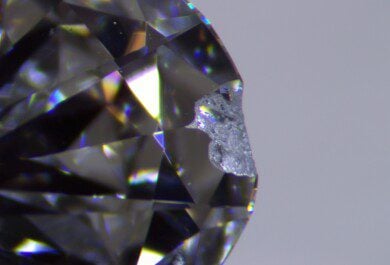Real World Information
Consumers should be aware that diamond grading happens on several different levels of quality attention by those performing the analysis.
Loose Diamond Grading
Diamonds costing hundreds or thousands of dollars should be graded by a top-tier laboratory, capable of detecting the most modern treatments, enhancements and lab grown origin.
Jewelry Identification and Grading
Diamond and gemstone jewelry costing hundreds or thousands of dollars should also be certified by a top-tier laboratory, capable of detecting the most modern treatments, enhancements and lab grown origin. The report should be item-specific, providing specific 4Cs assessment of the center stone (not split color or clarity grades), weight and precious metal alloy used for the setting and general details of all side stones, if present.
Department Store Grading
Generic reports accompanying economical pieces like those seen in department store jewelry counters should not be confused with loose diamond certification (or grading reports). These documents are not item-specific, they are mass-produced to describe a production run of numerous similar pieces. They are not nearly as strict, accurate or expensive as stand-alone diamond grading reports or jewelry identification reports, prepared for a specific piece.
Discount Diamond Grading
Discount sellers in commercial markets may diamond grading reports issued by organizations willing to intentionally over grade diamonds. This occurs when an appraiser, laboratory or seller continually promotes diamonds as having better color or clarity grades than they would normally receive according to strict, industry-accepted international standards, misrepresenting those diamonds to buyers.
Various EGL International overseas locations were exposed for over grading diamonds, prior to the organization being delisted by trading platforms, including PriceScope.
Intermediate Diamond Grading
Diamond Grading Process
Diamond grading at top-tier laboratories follows a strict sequence of intake, analysis and reporting.
Arrival
Upon receipt, a diamond’s manufacturer’s part number (MPN) is recorded, and a unique tracking number is assigned by the laboratory. This tracking number frequently becomes the diamond grading report number.
Diamond grading is anonymous. No company or submitter names are included which may identify the owner. Even the MPN may be redacted, to ensure no favoritism or bias. The most sophisticated laboratories include a chip in the diamond’s parcel by which it can be electronically tracked, to determine its location at any given moment. Analysis is conducted randomly and separately: the diamond returns to central control following each stage of grading, so the gemologists it becomes exposed to are random.
The first stage in diamond grading is weighing the diamond. Diamond grading scales are calibrated to three decimal places. Most laboratories establish carat weight to two decimal places, with the exception of the AGS, which reports to three.
Measurements
A diamond’s measurements are established using a 3D scan created in a diamond scanning device. In this process the diamond is placed upside-down on a rotary platform, surrounded by lights. The lights turn on and the silhouette of the diamond is captured eight times as it rotates. An integrated camera measures the angles of that silhouette.
2. Clarity and Finish Grading
The second stage of diamond grading is the analysis of clarity and polish & symmetry, known collectively as finish.
First Impression
The reason clarity analysis is traditionally performed before color analysis is so the ‘first impression’ for a solo grader is clarity. That first impression, at 10X magnification, will determine the broad range of clarity into which that diamond should fall. Diamonds with characteristics which are immediately obvious or noticeable at 10X will fall into the lower five grades, whereas diamonds with characteristics which are minor, minute or extremely difficult to find at 10X will land in the higher grades.
Polish, Symmetry and Treatments
The gemologist next examines polish and symmetry quality and inspects the diamond for any treatments or enhancements such as laser drilling and resin filling. The polish and symmetry grades, and existence of any treatments are recorded.
Plotting
The gemologist uses a process known as the wedge technique, examining the diamond in segments, noting the location and nature of all relevant clarity characteristics on a clarity plot, creating a map of its characteristics.
The third stage of diamond grading is an analysis of color and fluorescence, if present.
Upside Down Color Grading
Gemological laboratories perform diamond grading of D to Z color with the diamond upside down and viewed through the side. This is done to permit a neutral view. Viewing a diamond from the top is not neutral because of three factors which may influence diamond color appearance in the “face-up” position:
- The diamond’s shape
- The way the diamond was cut
- The presence of diamond fluorescence
The gemologist places the diamond face down, against a neutrally colored background, under diffused lighting. The subject diamond is compared to a set of calibrated master color stones, D-Z. Each master stone has the least amount of color in its range. This permits the gemologist to compare the diamond until it precisely matches a master stone, or lands below that master and above the next – in which case it’s the color of the higher master.
Fluorescence Grading
The gemologist inspects the diamond for fluorescence under special UV lighting. If fluorescence is present, the strength and color of the fluorescence is recorded.
Verification
With both clarity and color analysis, a second gemologist will take the diamond through the grading steps and provide a second opinion, completely independent from that of the first gemologist. When necessary, a senior gemologist reviewing the grades of the first two gemologists may record a third opinion. The color and clarity grades are only finalized when a consensus is reached. This helps minimize the subjective deviation present in diamond grading.
Most of the world’s diamond grading laboratories, including the GIA and the IGI, take a round brilliant diamond’s average proportions, according to its 3D scan, and apply them to diamond grading charts to establish the cut grade. Since the proportions are based on two-dimensional averages the cut grade is not diamond-specific. Most laboratories using proportions grading do not grade the cut of fancy shapes.
The AGS laboratories and GCAL import the diamond’s 3D model into software designed to follow the light as it travels through the diamond, taking its total sculpture into account. This computer modeling approach is called ray tracing and is diamond-specific. It can also be used to grade the cut of fancy shapes.
4C: Cut Grading: Finish
Grades for polish and symmetry are applied to the diamond grading process for cut. These finish grades, if lower than the proportions or performance grade, can cause the overall cut grade to be lowered.
5. Preliminary Reporting
After diamond grading stages 1-4 are complete a preliminary report is prepared and sent for the submitter/owner of the diamond to review. If the owner disagrees, they may ask the diamond grading laboratory to recheck certain grades (described below). Once preliminary reporting and recheck are complete the owner will send instructions to the diamond grading laboratory.
6. Laser Inscription
If the owner requests it, the diamond grading laboratory will laser-inscribe each diamond, typically with their internal tracking number, which now becomes that diamond’s grading report number. If the diamond belongs to a brand or specific store, the owner may also have a logo inscribed. These inscriptions will be noted on the diamond grading report.
7. Printing and Preparation for Return
If the owner requests it, the official grading report will be printed (except digital-only report formats). Diamond grading reports are printed with holograms and other security features, then laminated to prevent alteration. The diamond is weighed, verified as matching the report by central control, steam-cleaned and prepared for return to the owner along with the new diamond grading report, which is placed in a protective sleeve or binder.
8. Digital Grading Report Posted
Once the diamond and report have left the diamond grading laboratory premises a digital copy of the report will be posted online.












